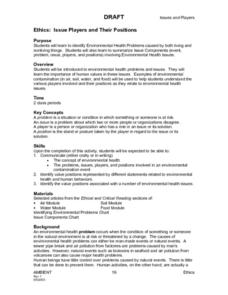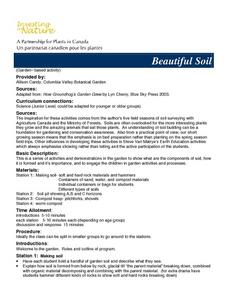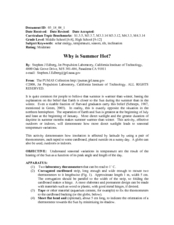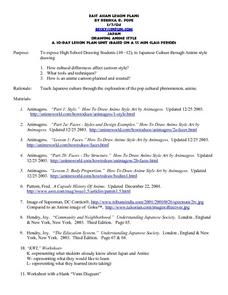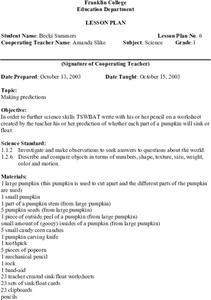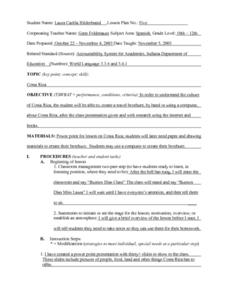Curated OER
Issue Players and Their Positions
Students identify Environmental Health Problems caused by both living and nonliving things. They summarize Issue Components (event, problem, issue, players, and positions) involving environmental health issues such as contamination in...
Curated OER
Ethics Activity: Issue Analysis
Students analyze environmental health issues with respect to the players, their positions, and associated values, after being introduced to the concepts of events, problems, and issues. They apply the skills of issue analysis to...
Curated OER
Dirty Air And Bright Lights
Students are asked to think about their use of electricity, particularly around the holidays, and how it affects their quality of life and the lives of all of us. They explore the issue by tracing the connections and discussing how and...
Curated OER
Well, Well, Well
Students consider a case of potential water contamination by using a process of reasoned discourse about the definition of the problem, the relevant information, and the values behind different solutions. They consider the role of...
Curated OER
Environmental Health Ethics
Students use inductive reasoning to study different scenarios related to environmental issues. They evaluate various scenarios to develop common definitions and key concepts in environmental health ethics.
Curated OER
With Liberty and Justice for all
Students act as are property owners who learn that soil on their property is contaminated with lead. They consider the issues involved in addressing this problem so that further harm is avoided and a fair solution is developed and...
Curated OER
Beautiful Soil
Students discover what are the components of soil. They examine how it is formed and it's importance. They engage in garden activities and processes. They hold a handful of garden soil and describe what they see. They take a...
Curated OER
Egg Hunt
Middle schoolers make detailed qualitative and quantitative observations. They are introduced to the process of developing repeatable procedures. Students practice collecting data. They review measurement skills. Middle schoolers...
Curated OER
Food Classification
Students are introduced to classification and some of the difficulties surrounding classification and how classification systems need to be able to adapt and how they may need to be changed when new information is discovered. They...
Curated OER
Dichotomous Key
Students draw comparisons between organisms. They classify organisms. Students are introduced to dichotomous keys and how to create and use a dichotomous key to identify a variety of objects. They begin by defining classification, and...
Curated OER
Apple Contractions
In this contractions worksheet, students find two leaves that make the contraction that is inside the apple. For example, for the apple that reads, "she's" students will find the leaves the read, "she" and "is."
Curated OER
Force & Acceleration
Students investigate the effects of weights on the motion of a toy car. In this force and acceleration lesson plan, students use different weights, a toy car, a paper clip and string to determine how a car will move as different weights...
Curated OER
Different Minerals
In this minerals worksheet, students read about the relationship between elements, rocks and minerals. They experiment using 6 different colored gumdrops to represent 6 common elements. Students construct gumdrop and toothpick models of...
Curated OER
Moving Bodies
In this moving bodies worksheet, students investigate how the amount of mass of a body in motion affects its tendency to remain in motion. Students use a meter stick as a ramp, marbles, string and a wooden block to determine how far a...
Curated OER
Experimenting With Motion
In this motion worksheet, students design an experiment to investigate motion. They form a question, they develop a hypothesis, they design an experiment and then answer 4 questions about their experiment.
Curated OER
Newton's Laws
In this motion worksheet, young scholars read about the 3 laws of motion and then complete a graphic organizer describing the laws and giving an example for each one.
Curated OER
Why is Summer Hot?
Students examine how variations in temperature are due to the Sun and length of day. In this solar instructional activity students complete a lab activity using thermometers and artificial sunlight to see how the earth is heated.
Curated OER
Money
Students examine ten pennies on their mats as they tell what they know about them. They follow verbal directions that are given by the teacher to count out specified numbers of pennies. They repeat the activity with dimes and talk about...
Curated OER
Drawing Anime Style
Young scholars use a graphic organizer to explore the drawing style known as Anime. They conduct research from a variety of internet resources to come up with a better comprehension of the style and how it is drawn.
Curated OER
Making Predictions
First graders write with his or her pencil on a worksheet created by the teacher his or her prediction of whether each part of a pumpkin will sink or float. They drop each of five objects in the water one at a time allowing enough time...
Curated OER
Flower Reproduction
Fifth graders examine the cycle of flower reproduction. They listen to a poem about a bee, observe and examine flowers in small groups, and develop a class KWL chart. Students then read about flower reproduction in their textbook, and...
Curated OER
Accountability System for Academics
Students explore, analyze and study the culture of Costa Rica and create a travel brochure, by hand or utilizing a computer, about Costa Rica. They complete their brochures and present them to their classmates and then turn them in for...
Curated OER
Naviagational Tools
Fifth graders create a compass, with the help of written instructions and then write six sentences discussing how compasses work and why they are helpful. They discuss the different types of navigational tools and how they are helpful.
Curated OER
How Many More on a Graph?
First graders identify a number that is one more or one less than a number up to one hundred and identify a mystery number. They also create a class graph that illustrates how many children are in each family, and answer questions about...


